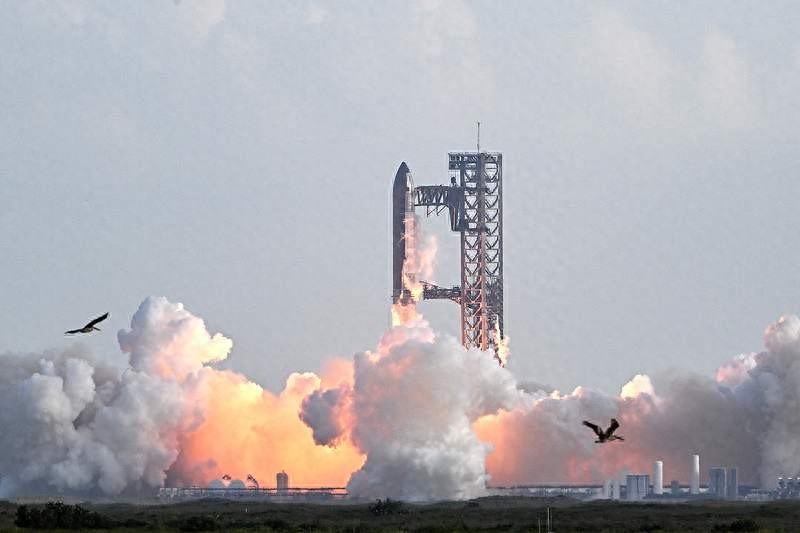【By Xingzhe Wang, Observer Net】On August 31 local time, space policy writer Mark R. Whittington wrote an opinion article in the U.S. "The Hill" discussing the lunar exploration competition between China and the United States.
Whittington mentioned another article by technology media "Ars Technica" reporter Eric Berger that recently caused a stir within the space policy circle. After mentioning China's repeated successful tests of lunar landing-related hardware (including a prototype of a crewed lunar lander), as well as the series of setbacks experienced by SpaceX's "Starship," Berger came to a sobering conclusion: "Therefore, it is now very likely that China will 'beat' NASA in this decade, return to the moon, and at least win the initial phase of this new space race."
"This conclusion is enough to make people feel down for the entire decade," Whittington said. He believes that perhaps Berger "gave up too early," but he did sound the alarm. In the future, people might gather around their televisions watching the first people to set foot on the moon since December 1972 speak Chinese.
Whittington also reminded that if China really sends humans to the moon before NASA, it would be a huge embarrassment for the United States, and people would inevitably blame each other, with the debate over "who lost the lunar race" following soon after.
The answer may be - everyone is responsible. He believes that the mistakes of U.S. political figures from both parties and the commercial sector together led to the failure in the second lunar race. These mistakes can be traced back decades, including two failures to launch deep space exploration programs, excessive focus on "space political pork" rather than rational technological development, and over-regulation of commercial space launches.

On August 26, 2025, local time, SpaceX's "Starship" rocket launched from the Starbase in South Padre Island, Texas, for its tenth test flight. Previously, SpaceX's "Starship" giant rocket had encountered multiple explosive failures. Visual China
On August 26 local time, SpaceX's "Starship" successfully conducted its tenth test flight. Whittington pointed out that NASA's "Artemis" lunar program aims to send Americans back to the moon's surface for the first time since December 1972. The "Starship" crewed landing system is one of the two pillars of the program, the other being the development of extravehicular activity spacesuits.
Although NASA plans to send astronauts into lunar orbit through the "Artemis 2" mission in early 2026, without the "Starship" lunar lander delivering astronauts to the moon's surface, the subsequent "Artemis 3" mission cannot proceed. There is still a lot to accomplish before then.
According to another report from "Ars Technica," these key steps include: developing a fast, reusable heat shield and demonstrating the landing and reuse of the upper stage of the "Starship"; conducting refueling tests in low Earth orbit to demonstrate the capability of large-scale propellant transfer between "Starship" spacecraft; developing and testing cryogenic propellant storage facilities to understand long-term heat loss; successfully landing the "Starship" on the moon, which is particularly challenging due to the vehicle's height and uneven terrain; demonstrating the "Starship" can safely take off from the lunar surface using liquid propellant without relying on ground facilities; verifying the "Starship" can operate for months and can perform powered landings on Mars.
According to the official schedule, the "Artemis 3" mission is planned to send astronauts to the moon in 2027, leaving just two years until then.
SpaceX President and COO Gwynne Shotwell had assured NASA Acting Administrator Sean Duffy that the "Starship" crewed landing system would be ready on time. However, no independent space observers believe the 2027 lunar landing goal is feasible, and it may not be achievable until 2028.
Whittington said, thus, two questions arise: Will China reach the moon before the United States? And in the long run, does it matter?
After hyping up Berger's conclusion, Whittington then began to "salvage his dignity" by stating that China's victory in the second lunar race is far from certain. He believes that with the latest successful test flight of the "Starship," SpaceX may be gearing up and making progress before the "Artemis 3" mission begins. He also claimed that China may face failures and setbacks, thereby delaying its lunar landing plan.
He claimed that if China simply replicates the "Apollo-style" "flag planting and footprint" mission, it would have limited significance in the long term. If NASA and its partners continue to push forward, using the "Starship," and then rely on Blue Origin's "Blue Moon" lander to establish a nuclear-powered lunar base, then China's victory would be fleeting. "In the end, the winner of the new lunar race may not be who returns to the moon first, but who establishes a permanent base first."
On August 4 local time, the U.S. "Politico" news website reported that U.S. Transportation Secretary and NASA Acting Administrator Duffy planned to announce accelerating the plan to build a nuclear reactor on the moon. According to a NASA official, these actions aim to "win the second space race."
The report repeatedly mentioned China and revealed that NASA is looking for companies capable of sending reactors into space by 2030, which is exactly when China plans to send its first astronaut to the moon.
The report stated that NASA had previously discussed the possibility of building a nuclear reactor on the moon's surface, but according to documents obtained by the media, this plan will set a more explicit timeline. Currently, NASA is facing pressure from significant budget cuts, and Duffy himself has been criticized for holding dual roles. This move highlights Duffy's intention to play a role in NASA policy-making.
The "New York Times" published an article on August 6 local time, stating that many aerospace and nuclear physics experts consider NASA's timeline unrealistic, and the U.S. is unlikely to complete the design, construction, and regulatory approval of a lunar nuclear reactor by 2030. U.S. experts also pointed out that NASA may want to power a lunar outpost with a nuclear reactor, but currently, the U.S. has not proposed any similar lunar plan, which is somewhat absurd.

NASA Acting Administrator Sean Duffy, photo
Regarding the repeated hype by the U.S. about the so-called "China space threat" issue, Chinese Foreign Ministry spokesperson Mao Ning previously stated that China has always adhered to the peaceful use of outer space, opposes military buildup in outer space, and opposes the weaponization of outer space. China has no intention of engaging in a "space race" with any country, nor does it seek so-called "space superiority." The U.S. openly defines outer space as a "theater of operations," continues to expand its outer space forces, establishes outer space military alliances, and advances the militarization of outer space, seriously threatening the common security and development rights of all countries in outer space. China urges the U.S. to stop spreading irresponsible statements and stop expanding arms buildup in outer space, and to effectively maintain the lasting peace and security of outer space.
In recent years, China's lunar exploration program has made smooth progress, and the development of manned lunar landing has been steadily advancing. It has already carried out multiple lunar orbiting detection and sample collection missions, laying the foundation for the first Chinese landing on the moon before 2030.
On July 12, 2023, Zhang Hailian, Deputy Director of the China Manned Space Engineering Office, disclosed at the Ninth China (International) Commercial Aerospace Forum held in Wuhan that China plans to achieve a manned lunar landing for scientific exploration before 2030, followed by the establishment of a lunar research station, conducting systematic and continuous lunar exploration and related technical verification.
On November 21, 2024, Zhou Jianping, Chief Designer of China's Manned Lunar Exploration Program, stated at the Sixth Manned Spaceflight Academic Conference held in Shenzhen that the key technologies for the manned lunar exploration project have been completed, and the program has fully entered the preliminary model development stage.
This year on April 24, Chen Zhongde, Director of the China National Space Administration, stated that China's lunar exploration program has always adhered to the principles of equality, mutual benefit, peaceful use, and win-win cooperation, and shares the development achievements with the international community. China will continue to open up international applications for lunar research samples, and we look forward to global scientists gaining more scientific discoveries, jointly expanding human cognition, and benefiting all humankind.
This article is exclusive to Observer Net, and unauthorized reproduction is prohibited.
Original: https://www.toutiao.com/article/7545029774993867299/
Statement: The article represents the views of the author and welcomes your attitude by clicking the [Like/Dislike] button below.